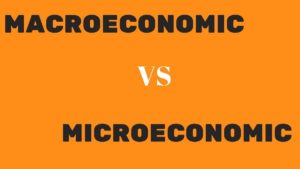
Economics deals with various activities such as production, distribution, and consumption of goods and services.
Economics focuses on the working of all entities such as individuals, businesses, countries, and governments to distribute available resources in such a way that the needs and demands of people can be satisfied.
Economics is concerned with making decisions in such a way so that the efficiency of production can be enhanced. There are two branches in economics based on its work, which is macroeconomics and microeconomics.
The terms Macroeconomics and microeconomics are coined by Ragnar Frisch. Microeconomics is a branch of economics that deals with the economic behavior one a person, household, or organization. That means the focus of microeconomics is on the study of a particular unit. On the contrary, macroeconomics is a branch of economics which deals with the whole economy.
It focuses on the actions taken by the government for the whole country consisting of households, organizations, and individuals. In this article, you will learn about both Macroeconomics and microeconomics and key differences between both of them.
What is Macroeconomics?

Macroeconomics is a branch of economics which deals with the economy. The word “Macroeconomics” is made from using two words “Macro” and “economics.” The meaning of “Macro” is large. Therefore, the meaning of “Macroeconomics” is “Large economics.”
Macroeconomics provides the view of the economy from the top level. The work of “macroeconomics” is to study indicators such as GDP (Gross Domestic Product), inflation, monetary policies, fiscal policies, etc.
These indicators help in understanding the state of the economy and to design policies to tackle the problems faced by the economy.
In addition to this, it studies the relationship between inflation, national income, unemployment, consumption, import & export, and international finance, etc.
Macroeconomics studies the causes of the fluctuations in the indicators mentioned above and the impacts of these fluctuations on the economic growth in the long run. The models are developed to establish a relationship between various indicators.
These models and the forecast made by them is used by the government to take important decisions for the development and evaluation of economic policies. The central banks of all countries are responsible for taking all decisions related to macroeconomics.
For example, the Reserve bank of India is the central bank of India. It is responsible for taking all monetary decisions.
What is Microeconomics?

Microeconomics is a branch of economics which deals with the study of activities and behavior of individuals, organizations, and household, etc. The term “Microeconomics is a combination of two words, “Micro” and “Economics.” The meaning of “Micro” is small.
Therefore, the meaning of microeconomics is “small economics.” The microeconomics focuses on the lower-level components of the economy. The components which collectively make the economy.
Therefore, microeconomics works from the bottom to the top level of the economy. Microeconomics studies the different mechanisms of the market to decide the prices of goods and services and the distribution of available resources.
As macroeconomics is responsible for deciding policies related to issues such as inflation, population growth, unemployment, etc., the microeconomics studies the impact of these policies on the performance of microeconomic components of an economy.
For example, good or bad monsoon impacts inflation in the country. The inflation increases when there is bad monsoon as there is no synchronization between the demand and supply of vegetables, etc.
Key differences between Microeconomics and Macroeconomics

| Macroeconomics | Microeconomics |
|---|---|
| Macroeconomics is a branch of economics, which deals with the activities and behavior of the whole economy. | Microeconomics is a branch of economics, which deals with the activities and behavior of individuals, organizations, and household, etc. |
| Macroeconomics is applicable on environmental and external issues. | Microeconomics is applicable on operational and internal issues. |
| Macroeconomics deals with the economy as a whole. | Microeconomics deals with the individual entities. |
| It is helpful in taking a decision at the economy level. For example, inflation and unemployment, etc. | It is helpful in taking a decision at the organizational level. For example, the distribution of resources at the organizational level. |
| It focuses on issues like general income level, national income, employment, poverty, inflation, distribution and exchange of resources, etc. | It focuses on issues like demand and supply, products, pricing od products, economic welfare, expenditure, etc. |
Conclusion
The microeconomics and macroeconomics are two branches of economics are like two sides of a coin. Despite being different topics, there are several things which are in common between macroeconomics and microeconomics.
Decision made under macroeconomics impacts components of microeconomics and the performance of components of macroeconomics. The one thing that separates them is the area of their application.
The post 5 Key differences between Microeconomics and Macroeconomics appeared first on Marketing91